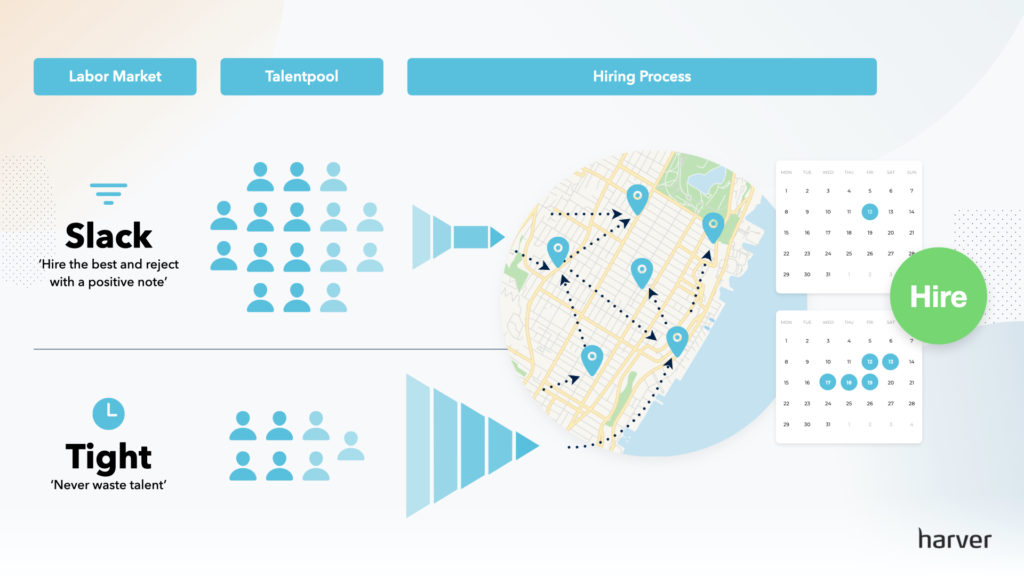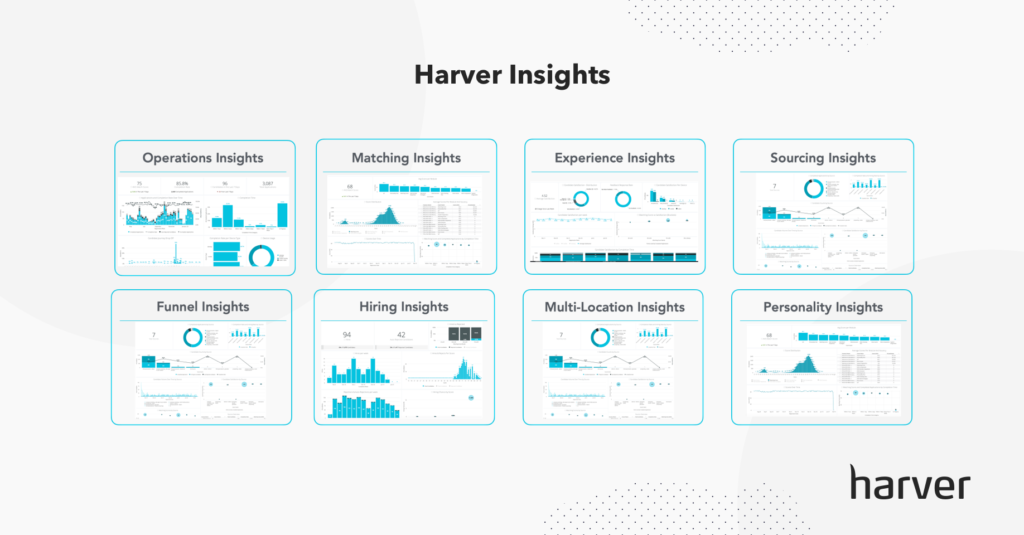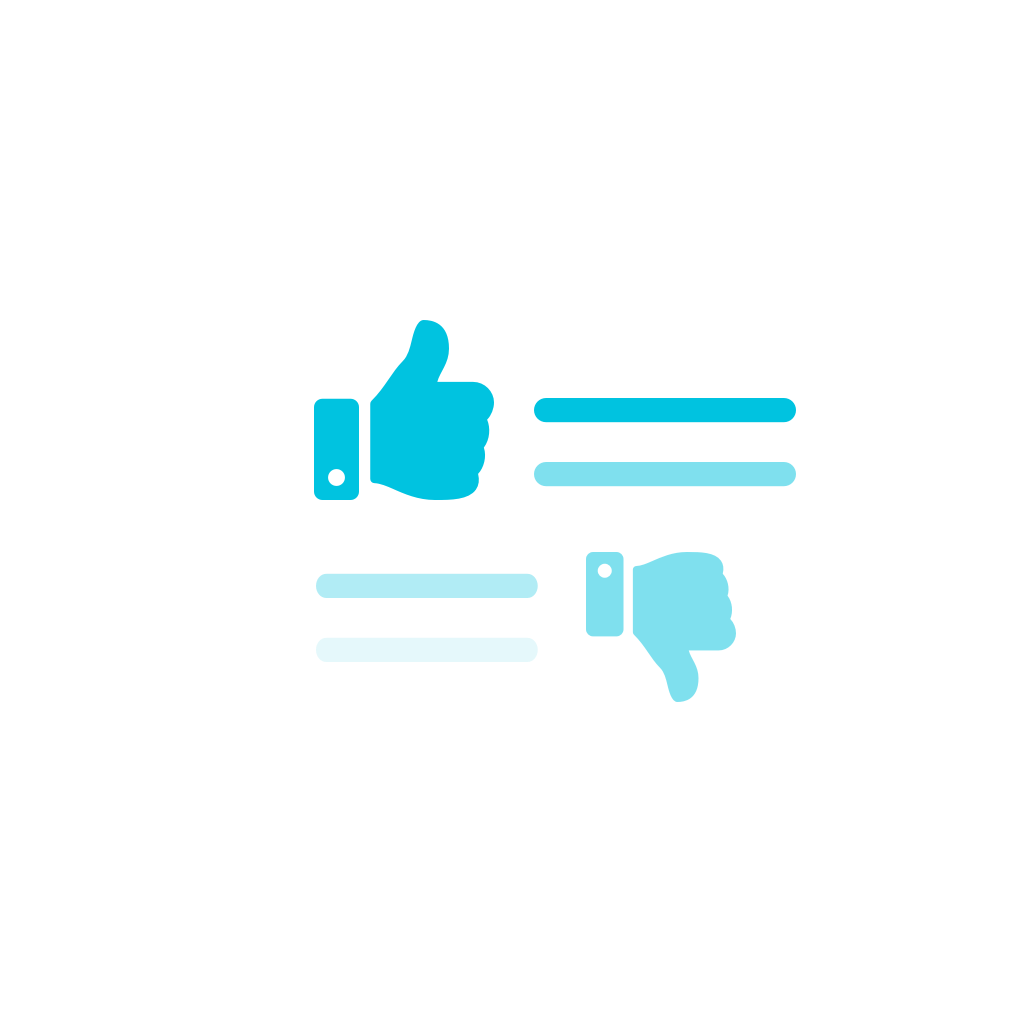Recruitment experts are referring to this time as the “Great Resignation,” as more workers quit their jobs for better pay and protection from COVID-19.
Around the world, companies across various industries are struggling with staffing amid the tight labor market, including retail, restaurants, healthcare, and more.
The truth is, labor market ebbs and flows are a reality in the talent acquisition biz, and hiring in a tight or loose labor market—especially when hiring at scale—requires companies to follow a specific recruitment strategy to accommodate fluctuations.
Let’s talk about steps your recruitment team can take to prepare for handling labor market shifts when volume hiring for your organization.
What’s in?
Like what you see?
Don’t miss out. Subscribe to our quarterly digest to get the latest TA and TM resources delivered right to your inbox.
Tight labor markets: What you need when hiring at scale
A tight labor market, much like the one today, occurs when there are too few candidates to accommodate a company’s or industry’s demand. As of September 2021, there are currently more than 10 million open roles in the U.S. alone—particularly among certain industries prone to turnover that regularly practice volume hiring.
Take the labor market in the restaurant industry, for example. Restaurants, especially in the quick-service business, are certainly no strangers to high turnover. With demand rising faster than companies can hire, this presents a significant challenge for recruitment teams.
The worker shortage in restaurants has reached an all-time high, with 1.7 million fewer jobs filled than before the COVID-19 pandemic began—despite open job postings for almost a million openings in just one month.
So, what’s the expert take on the labor market as it exists today?
“Every candidate in this country is more valuable today than they were a few months ago. And that’s from the CEO or the experienced Java programmer in Buffalo, New York, to the person willing to walk into a factory. Everyone is now more valuable, explained Evan Sohn, chairman, and CEO at recruiter.com.
“And I think people are beginning to recognize that they’re more valuable. We saw salaries increase slightly. It really is a candidate’s market today.”
To adapt to the type of tight, highly-competitive labor market Sohn described, you need to adopt a flexible, end-to-end recruitment solution that allows you to:
Source efficiently and at scale
You and your talent acquisition staff need the ability to source candidates at scale, with minimum effort on your team’s part, in a smooth and predictable manner. This way, you can find a high volume of candidates quickly, without running into unnecessary hiccups or increasing the number of manual tasks and/or full-time employees on your team.
If you’d like to see how Harver can help, you can book a demo below.
If you’d like to see how Haver can transform your hiring process,
book a demo here!
Streamline the recruitment process
Along with sourcing efficiency, you also need technology that enables you to move candidates through the recruitment funnel quickly. This will allow you to offer top applicants job security as fast as possible, so hopefully, you can bring them on board before they accept another position elsewhere.
Route candidates between locations
It’s also a good idea to find a solution that lets you route candidates between locations when hiring for multiple locations at one time. This helps to ensure a balanced distribution of the talent who applies, and also provides support when staffing tough markets, as this will help make sure no location is left without candidates.
We’ve detailed the topic in the article below.
Adjusting your recruiting process for a loose labor market
On the other hand, loose labor markets—or what some refer to as labor market slack—occur when there are more underemployed or unemployed candidates than job openings. This is another example of uneven labor supply and demand, in reverse.
For example, in Europe, unmet demand for employment reached 14.2% of the extended labor force in the fourth quarter of 2020. Less than half of that number, or around 6.9%, were actually unemployed; however, the other half were still less-than-satisfied with either their position itself, the organization as a whole, a limited amount of work for hourly employees, and/or compensation and benefits.
In the U.S., the 2008 recession is an extreme but relevant example of a loose labor market. At the beginning of “the Great Recession”, one in five employees lost their jobs with a staggering unemployment rate of 10%. It’s also interesting to note that while the current U.S. labor market is tight, some would also consider it loose.
It’s a unique situation because while the pandemic caused a rapid unemployment rate increase (from 3.5% to 5.9%), employers still can’t seem to hire and retain the staff they need.
How does recruiting in a loose labor market differ from a tight labor market?

In a loose labor market, you can be much more selective when choosing your top candidates. This essentially means you can filter out more applicants early on, and add steps to the recruitment funnel, like pre-hire assessments, which will help you achieve the highest quality of hire (QoH).
Although your company’s quality of hire matters more than the speed of hire, process efficiency in recruitment is still essential—regardless of changing labor market conditions. To maintain your quality of hire and increase volume hiring efficiency in a loose labor market, you need technology that allows offers:
A wide variety of pre-hire assessments
Scientifically validated, pre-employment assessments help you make better hiring decisions, predicting quality of hire and job success, while also delivering a superior candidate experience and mitigating unconscious bias.
You can assess candidates on a number of different characteristics, from hard skills like multitasking and typing, to cultural fit, personality, cognitive ability, learning agility, situational judgment, and more.
Customization options for application flows
To accommodate volume hiring in a loose labor market, you also need software with the ability to build custom application flows. This way, you can tailor the process to your organization’s specific hiring needs, while also providing a truly accurate preview of what it’s like to work for the company.
With the right volume hiring technology, you can also develop different application flows for each individual job opening.
How to build agility into your volume hiring process
To be able to handle these labor market shifts without having to scale your recruitment team up or down whenever there’s a change in the supply or demand, you need to develop an agile, end-to-end digital hiring process that removes most manual tasks and allows you to handle hundreds of candidates in one go.
This can be achieved by making sure your HR and recruitment tech stack consists of tools that are purpose-built with volume hiring in mind. Here’s what to look for in a volume hiring platform:
Modularity
One essential for building agility into your volume hiring process is modularity. You need modularity in your recruitment process because it allows you to adjust your sourcing, application, and selection flows as needed, based on fluctuating markets.
This means that when there are too many candidates at one time, you can create longer application flows and use different combinations of assessments to filter some of them out early on. When there are too few candidates, you can shorten the process and use only a few assessments, to ultimately maintain recruitment efficiency and offer job security in the shortest amount of time.
Flexibility
Volume hiring in changing labor markets also requires recruitment technology that offers you flexibility when you need it. This way, you can scale up and down at the push of a button, without needing to increase your recruitment budget, resources, or full-time recruiter headcount.
With this approach, to handle more applications, you won’t need more recruiters; The entire process from sourcing up to the interview stage is automated, including the scheduling of interviews for your selected candidates. Applicants can self-schedule interviews and record videos to make recruiters’ jobs easier during this stage.
Flexibility should extend to pre-hire assessment modules as well, where you can add more or fewer questions, essentially making your criteria more or less restrictive.
Data visibility
These days, nearly everything in business is data-driven—so why shouldn’t hiring be the same? Visibility into essential recruiting metrics, both operational and candidate-specific, is necessary in order to easily identify potential weaknesses and bottlenecks throughout each stage of your recruitment funnel.
Keep in mind that your entire talent acquisition team needs to have access to a single source of truth for data interpretation, which will help ensure accuracy.
You need to know which sources bring the best candidates, wherein the funnel they drop off, which assessments lead to a higher quality of hire when to use cultural fit assessments, and more—all of which can be learned by digging into various recruitment data sources.

Customization
Then there’s customization, which is especially important to adapt to changing labor markets. Recruitment solutions with customization options help recruiters attract candidates and stand out among competitors.
In fact, with the right customization capabilities, you can get creative when it comes to how your application process looks. This is facilitated by candidate experience and employer branding solutions, which have the potential to dramatically enhance the application stage for your potential employees.
Final thoughts on hiring amid changing labor markets
As we continue to face the uneven and hard-to-predict labor market caused by the COVID-19 pandemic, one learning becomes clear: Your entire recruitment funnel needs to be agile and adaptable, so you can adjust your process quickly and on an as-needed basis without making other changes.
However, to do that effectively, you need the right recruitment technology to help you hire at scale, regardless of the state the labor market is in. With the right technology and the right strategic approach, your recruitment team and larger organization will both be prepared for an uncertain future and whatever’s to come.
That’s where Harver comes in. Harver is built for volume, and it can handle the entire recruitment process for you from “Apply” to “Hire”.
Ready to transform your hiring process?






